Autism in Horror/Dark Literature: PARABLE OF THE SOWER
Parable of the Sower, by Octavia Butler, has been praised and rendered as an almost spooky coincidence, an eerie prediction of the future, made in Butler's, and now our's, doomsday past; black scholars and writers state that it was no mere accident that Butler had accurately predicted our world's economic and ecological demise, currently beginning to unfold before our very eyes, nor were the ideas conceived and carried out in Parable of the Sower merely stuck in the social-political climate of 1993 and severed from the Grim Reaper's crystal-ball nightmares, attached to a future we'd never live to see; Butler writes about loops of time. What it takes for them to break.
In the book Octavia's Brood: Science Fiction from Social Justice Movements and Parable of the Sower, an anthology collection interested in examining the deeper meanings behind Butler's work while simultaneously applying her character's liberations, to our current material reality. The editor, one of the contributors, and a long-time fan of Butler, Adrienne Maree Brown points to the importance of speculative fiction serves not only as a hopeful manifesto, encouraging the freedoms of all black, indigenous, queer, poor, and disabled peoples, but a tool for powerful manifestation. A creative birthing of love, care, and transformative justice sprouting from a page and serpenting through others' lived understanding of selves. Their rights to live joyfully, without the threatening hands of America, watching. Waiting. And to have the imagination to make a change happen.
In another one of Brown's books, Pleasure Activism: The Politics of Feeling Good, throughout the chapters, interviews, and essays, other authors and Brown reminisces on the sci-fi world-builders they grew up with and inspired their self-love journeys; Brown brings up Lauren Oya Olamina, the protagonist in Parable of the Sower and the founder of Earthseed, a "God is change" centered religion, as an example of a neurodivergent mind, existing in imaginative works.
Olamina is someone who experiences "hyper-empathy" due to her mother using drugs while pregnant, and allows her to physically feel her emotions as her own; this includes pain, which is difficult for her character for hundreds of reasons. Yet, this ability to "share" allows Olamina to discover her calling amongst the world: to spread the word of Earthseed. To survive, not just within her community, but for the world to heal along with the promise of change. The promise to not rely on the president, or his lies to "take care" of everyone who chooses to live in his company towns. Radicalized by the belief that actions can directly shape God, manipulating the conditions of their lives. Not the other way around.
Although having hyper levels of empathy can be connected to a lot of different existing neurotypes (and in many neurotypical people as well), I do have personal memories where I experienced an over-abundance of empathy, to the point where it debilitates my own feelings of security and happiness, and a lack of empathy (some calling it hypo). But truthfully, that doesn't mean I divert from feeling (even though sometimes, I literally do) - it's more of a "switch" to cognitive empathy. An understanding of why a person hurts, and because I value their humanity, I can both imagine and rationalize their behavior. Either way, topics of empathy can sometimes feel like a powerful spell taking over my body; bursting into tears, because I can feel the budding of someone else's pain, searing inside me or I terrified because the person noticed that I'm not practicing "empathy" in what has been deemed the only humane way to do so. Fearing now that they see me as "evil" or "cold".
One of my least favorite stereotypes of autistic people is that we are "justice-seeking" people; I think some people's idea of justice wouldn't be considered ethical, radical, or even remotely close to centering people, and it's dangerous to portray all autistic people, especially one's who participate in white supremacy, as inherent "advocates" for the goodness of the world. I don't think every autistic person does or could experience the vast connection with humanity that Olamina feels with Earthseed. I do think, however, that Olamina exhibits a profound ability to subvert external programming that significantly improves her survival and outlook in life, like in some instances of neuro-nonconformity.
I had the privilege of reading Parable of the Sower in an adapted, graphic novel edition and to be honest with you, as someone who is watching the United States' descent further and further into its already existing fascist mindset and genocidal violence, it was a tough, yet artistically necessary read, that I think explores the colors of an apocalypse extremely well. The sharp angles, the use of splattered rusted red and desert orange, and the double-layered-ness of all chaotic, desperate movements (i.e. a bird, shot in the sky, or a dangling arm, severed and dripping with blood), I think really spoke to the direness of disaster, built on a world that we are beginning to know. Some, unfortunately, already aquatinted.
Visually seeing Parable of the Sower and the horrible events, plaguing Olamina and her community, I really believe adds to Butler's beautiful metaphor for the Earthseed religion: connection beyond the markings of reality. Dreaming something better for all.
Posts